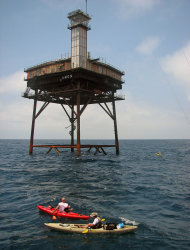First, some renovations will be needed at the Diamond Shoals Light Tower,
which sits about 13 miles off Cape Hatteras. Its buyer hopes to get his
first view of his new property next week — provided, of course, that
the landing pad is sturdy enough for a helicopter.
 "The pilot says he's confident it will be OK," said Dave Schneider
of Richfield, Minn., who plans to chopper out Wednesday for his first
look. "He says if we try to land and it looks shaky, we're not going to
land."
"The pilot says he's confident it will be OK," said Dave Schneider
of Richfield, Minn., who plans to chopper out Wednesday for his first
look. "He says if we try to land and it looks shaky, we're not going to
land."
Schneider, 56, paid
$20,000 for the tower and platform in September after he was the only
bidder for it in an auction by the General Services Administration,
which sells real estate that the federal government no longer needs. In
doing so, he brushed aside the GSA's 2-year-old inspection that concluded it would cost $2.3 million to renovate the structure that resembles an oil rig platform.
He
pored over the 125-page engineering report before deciding it wasn't in
as poor shape as it first appeared. It's sturdy, sitting in 50 feet of
water and with pylons going 150 feet into the seabed. Of the renovation
estimate, $1 million is for a boat-winching system and boat, neither of
which he needs. Another $189,000 was earmarked for contingencies, and
part of the renovation was for labor, some of which Schneider will do himself.
And then, there's the view."When you look at real estate, it's always location, location, location," he said. "Who wouldn't want to have a location in the Atlantic Ocean?"
The
Diamond Shoals Light Tower was made operational in 1966 to help ships
cross a treacherous area nicknamed the Graveyard of the Atlantic. It was
automated in 1977, removing the need for a full-time Coast Guard Crew.
Its condition deteriorated over the years, and the light was
extinguished in December 2001.
Schneider plans to be on the tower
for four to five hours Wednesday, using cameras on hard hats to record
his tour of each room, including getting measurements for all of it. The
living quarters housed below the landing pad include five bedrooms, a
galley and a recreation room.
The light tower isn't the only unusual property available through GSA auctions.
For example, the former Stanley Mickelsen Safeguard Complex near
Hampden, N.D. — the country's first anti-ballistic nuclear missile
defense system — is up for grabs, as is a cave storage facility in
Atchison, Kansas. Some properties never go up for auction, said Lori
Dennis, GSA branch chief in real property utilization and disposal in
Atlanta.
The government worked
with local leaders to turn a former munitions plant in Chattanooga,
Tenn., into a Volkswagen plant that makes Passats, she said. "We do get a
lot of unusual properties, and we're traditionally successful at
getting rid of them," she said.
Business-oriented, methodical
people tend to buy traditional properties such as federal buildings,
while more daring, entrepreneurial types buy nonconventional properties
such as light towers, she said.
That's true of Schneider, who is president of a supplies and logistics that works with government
contracts. He also serves as president and CEO of Zap Water Technology,
which installs equipment that turns water and salt into an eco-friendly
sanitizer and cleaner in meat plants, schools and other places.
He
wants to use the tower for research not only by Zap Water, but by other
companies. He envisions researchers taking advantage of the tower's
enormous space to study wind turbines, solar power, climatology, metal
coatings, marine biology, and other subjects.
"There's tons of different research industries I would like to bring out there," he said.
Before
Schneider bought the tower, he consulted Richard Neal of Mint Hill, who
bought North Carolina's other light tower two years ago for $85,000.
After restoring the tower in Frying Pan Shoals, including adding a hoist
so people can get from a boat to the tower without climbing, he opened a
bed and breakfast at the site in June. For $300 per person, plus the
cost of transportation, people can spend a weekend diving and fishing or just watching movies and sunsets from 30 miles off Southport.
His
advice? "Keep the long-term perspective. Fix the things you need to fix
first. Keep a healthy dose of patience and explain to people what
you're trying to do. And they'll want to help."
Schneider
does hope to recruit volunteers willing to help renovate the tower in
exchange for some breathtaking views and unmatched fishing and diving
opportunities.
He said he's no
different than the person who wants to restore a 1966 Camaro and sees
one that's rusted and dilapidated but still beautiful. "I have the same
situation. It's just a heckuva lot bigger," Schneider said. "It's old,
it's rusty and it was made in 1966. But there's a lot of potential
there."
And as for that landing pad?
"They just said they couldn't guarantee it was safe," he said.

No comments:
Post a Comment